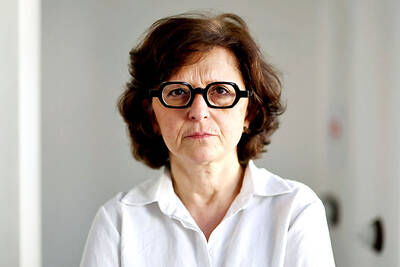An arid expanse of California desert at the southern end of the San Andreas Fault is being wired with high-tech sensors that scientists hope will tell them when the state’s sleeping giant could awaken.
The effort could not be more timely. For the past week, a swarm of more than 250 earthquakes has jiggled the desert where the first new seismic instruments were installed earlier this year.
“Even the smallest little bump shows up there,” said Bill Curtis, demonstrating the sensitivity of the new monitors with a foot-stomp that created telltale squiggles on a connected laptop.
Curtis, a field technician with the US Geological Survey (USGS), was satisfied that the newly installed instruments work.
Of the more than 300 known earthquake faults that crisscross California like a maze, the San Andreas is the premier fault line.
The nearly 1,287km fault runs from a peninsula just north of San Francisco to the Salton Sea, 200km southeast of Los Angeles.
In the first large-scale monitoring upgrade to one of the Earth’s most infamous cracks, scientists are showing unprecedented attention to the forgotten southernmost section, which has not ruptured in more than three centuries and is thought to be the most ripe to break.
Crews are hopscotching the southern San Andreas, burying motion sensors within 4.8km of the fault in hopes of catching the next “Big One.”
“We’re data-poor here,” said Ken Hudnut, a USGS geophysicist. “We don’t have the past record to tell us what’s going to happen.”
The USGS maintains a sprawling network of 300 seismic stations across the state. They automatically estimate a temblor’s size when the ground heaves and beam real-time data to a central hub in Pasadena, alerting that an earthquake has hit.
Since the southern San Andreas poses a significant danger to the roughly 20 million residents living near it, scientists decided to pepper the fault with 11 new seismic stations and update six old ones.
Each San Andreas station contains two sensors to measure speed and acceleration as well as a data-logger and a mini-computer that can process seismic signals without having to rely on the central hub.
The entire southern end upgrade will cost more than US$500,000, financed by a USGS grant. The instruments cost US$40,000 plus an extra US$15,000 for solar panels, antennas, construction and labor.
On a recent afternoon, USGS seismologist Doug Given and a team of technicians tested seismic equipment near the fast-growing Coachella Valley, a desert playground for golfers and sun-worshippers.
Surrounding them were the Mecca Hills, a maze of eroded canyons and badlands lifted up by the nonstop geologic bump and grind of the North American and Pacific plates.
The new sensor was installed near a dry creek bed on federal property next to a private mining company. The location had a line of sight to a communication tower, but it was remote enough that four-wheel drive was needed.
“It’s kind of like parking a Cadillac Escalade out here and leaving it,” Given said of the costly seismic equipment.
By clustering sensors along the southern edge, scientists hope to get faster readings of when quakes occur on the San Andreas and to better understand the science behind how faults break.
Eventually, they hope the sensors could be incorporated into an early warning system in Southern California — a goal that is still years away.
“What we’re after is measuring the ground motion,” Given said. “The closer you are to the source, the sooner you know an earthquake has begun.”
Any time a small fault next to a bigger one breaks, it slightly increases the chance of a larger quake, but that risk rapidly decreases with time.
“That doesn’t mean this section of the San Andreas is the next to go,” Hudnut said. “The San Andreas likes to demonstrate how irregular its behavior can be.”
The work recently paid off. Newly installed seismic stations along the eastern shores of the Salton Sea were among the first to pick up the recent swarm, which broke a fault perpendicular to the San Andreas.
The sensors have been sending back valuable data that scientists are only beginning to analyze.

BACKLASH: The National Party quit its decades-long partnership with the Liberal Party after their election loss to center-left Labor, which won a historic third term Australia’s National Party has split from its conservative coalition partner of more than 60 years, the Liberal Party, citing policy differences over renewable energy and after a resounding loss at a national election this month. “Its time to have a break,” Nationals leader David Littleproud told reporters yesterday. The split shows the pressure on Australia’s conservative parties after Prime Minister Anthony Albanese’s center-left Labor party won a historic second term in the May 3 election, powered by a voter backlash against US President Donald Trump’s policies. Under the long-standing partnership in state and federal politics, the Liberal and National coalition had shared power

CONTROVERSY: During the performance of Israel’s entrant Yuval Raphael’s song ‘New Day Will Rise,’ loud whistles were heard and two people tried to get on stage Austria’s JJ yesterday won the Eurovision Song Contest, with his operatic song Wasted Love triumphing at the world’s biggest live music television event. After votes from national juries around Europe and viewers from across the continent and beyond, JJ gave Austria its first victory since bearded drag performer Conchita Wurst’s 2014 triumph. After the nail-biting drama as the votes were revealed running into yesterday morning, Austria finished with 436 points, ahead of Israel — whose participation drew protests — on 357 and Estonia on 356. “Thank you to you, Europe, for making my dreams come true,” 24-year-old countertenor JJ, whose

A documentary whose main subject, 25-year-old photojournalist Fatima Hassouna, was killed in an Israeli airstrike in Gaza weeks before it premiered at Cannes stunned viewers into silence at the festival on Thursday. As the cinema lights came back on, filmmaker Sepideh Farsi held up an image of the young Palestinian woman killed with younger siblings on April 16, and encouraged the audience to stand up and clap to pay tribute. “To kill a child, to kill a photographer is unacceptable,” Farsi said. “There are still children to save. It must be done fast,” the exiled Iranian filmmaker added. With Israel

NO EXCUSES: Marcos said his administration was acting on voters’ demands, but an academic said the move was emotionally motivated after a poor midterm showing Philippine President Ferdinand Marcos Jr yesterday sought the resignation of all his Cabinet secretaries, in a move seen as an attempt to reset the political agenda and assert his authority over the second half of his single six-year term. The order came after the president’s allies failed to win a majority of Senate seats contested in the 12 polls on Monday last week, leaving Marcos facing a divided political and legislative landscape that could thwart his attempts to have an ally succeed him in 2028. “He’s talking to the people, trying to salvage whatever political capital he has left. I think it’s